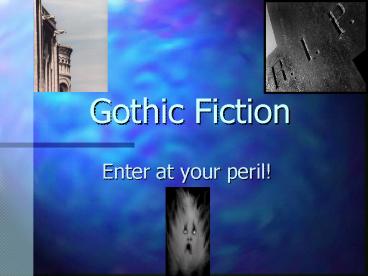Gothic Fiction - PowerPoint PPT Presentation
1 / 24
Title:
Gothic Fiction
Description:
In general, the Radcliffian Gothic incorporates an innocent that is imperiled by ... [sic]; if not, more pleasingly, fairies of the legendary order, wooing their ... – PowerPoint PPT presentation
Number of Views:1831
Avg rating:3.0/5.0
Title: Gothic Fiction
1
Gothic Fiction
- Enter at your peril!
2
Definition
- A non-realistic writing style, which came to
prominence in the 1760s continues to the
present day. - It is referred to as a mode or style of writing
3
Gothic Context
- The gothic was first used as a Medieval,
architectural term to describe a style of
building that included gargoyles, scenes of Hell,
and souls in torment.
4
Examples of Gothic Architecture
- Notre Dame Cathedral
- St. Etienne
- Westminster Abbey
- Are all examples of Gothic Architecture
- The term was generally meant as an insult. It is
a reference to the Goth and Visigoth invaders,
who were looked upon as barbarians.
5
The Early Gothic
- Horace Walpoles The Castle of Otranto (1764) is
generally considered the first full-fledged
Gothic novel.
6
- The classic Gothic novels were written by Matthew
Lewis, Jane Austen, and Ann Radcliffe in the
1790s.
7
Radcliffe creates the formula for the classic
Gothic novel in The Mysteries of Udolpho.
- In general, the Radcliffian Gothic incorporates
an innocent that is imperiled by his/her own
innocence. - A guardian/protector figure, who must rescue the
innocent from unmentionable evil. The irony of
the Radcliffian Gothic is that it is the naiveté
of the innocent that puts the innocent at risk in
the first place. - Critics, like Kate Ferguson Ellis, have argued
that the Gothic mode of writing replays the felix
culpa or fortunate fall.
8
Contemporary Writers
- twenty-first century Gothic artists include Anne
Rice, Stephen King, Angela Carter and Patrick
McGrath.
9
The Gothic may be described using the following
characteristics
10
Degeneration, Darkness, and Decay
As a rule, gothic literature is generally set in
darkened scenes of degeneration and
decay. Popular settings include decaying houses,
crumbling castles, ancient abbeys, antiquated
priories, and moldering manor houses. Gothic
settings use physical descriptions of
degeneration to emphasize moral, spiritual,
cultural, and or psychological decay. Setting
can thus be said to be symptomatic of social
entropy.
11
There is an emphasis on the psychology of
the characters rather than plot. Things do not
always make sense logically in gothic texts.
Psychology
12
There is an emphasis placed upon extreme
emotional situations.
The Gothic goes to extremes.
13
Use of the supernatural
14
Use of the doppelganger theme
Doppelganger is a word that comes to us from the
German. It means living double. The doubling
of animate and inanimate objects is a major motif
found in gothic literature. These mirror images
often show a split between the characters public
and private self.
15
Use of an unreliable narrator
16
Dark, pessimistic view of existence
17
Change
There is a general emphasis on metamorphosis and
transformation this may manifest itself as a
physical or psychological change or both.
18
American v European Gothic
- The American gothic is different from the
European gothic for 3 reasons - Americas lack of historical breadth (theres
less loss history to be found). - Protestant foundation
- No abandoned/crumbling castles, monasteries,
priories, abbeys, etc.
19
Poe and the Gothic
- Edgar Allan Poe invents the American Gothic.
- In creating the modern horror story, Edgar Allan
Poe redefines the gothic. Poes gothic is
distinctly American in taste and setting.
20
Southern Northern Gothic
Within the American Gothic, there are two
distinct movements that are tied to geography
the Northern Gothic and the Southern
Gothic. Both express a fear of social entropy.
21
Henry James (1843-1916)
- Born into a family of wealthy intellectuals
- His father, Henry James, Sr., was a leading
intellectual of his day, who was friends with
Henry David Thoreau, Ralph Waldo Emerson, and
Nathaniel Hawthorne. - His brother William James was a pioneer in the
field of psychology.
22
James Background
- James was interested in literature, philosophy
and psychology. - He wrote 112 short stories, 20 novels, 12 plays,
numerous essays, and literary criticisms. - His writing is heavily influenced by Charles
Dickens, Nathaniel Hawthorne, and the French
writer Balzac.
23
Jamess Literary Style
- James is generally classified as a Realist
writer. - In TOTS, he deliberately sets out to write a
Romantic text. - While there are strong Gothic/Romantic elements
in TOTS, James strives to convey his story as
realistically and pragmatically as he can. - James is concerned primarily with the
psychological effect his writing has on his
audience.
24
The Turn of the Screw
- In 1908 he James wrote that Peter Quint and
Miss Jessel are not "ghosts" at all, as we now
know the ghost, but goblins, elves, imps, demons
as loosely constructed as those of the old trials
for whichcraft sic if not, more pleasingly,
fairies of the legendary order, wooing their
victims forth to see them dance under the moon."
- www.kirjasto.sci.fi/hjames.htm































